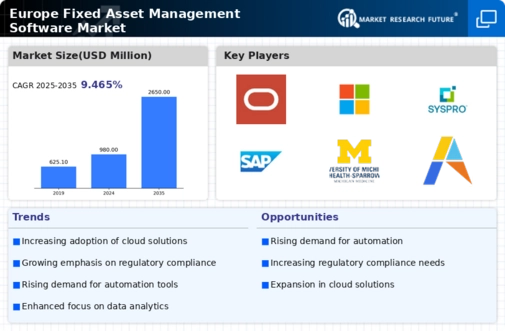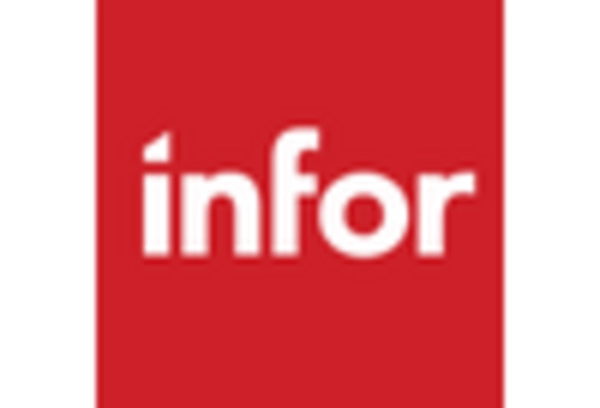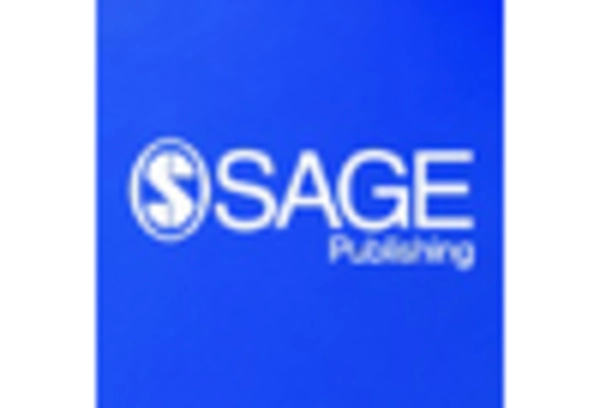Regulatory Compliance Pressures
In Europe, the fixed asset-management-software market is significantly influenced by the increasing pressures of regulatory compliance. Organizations are required to adhere to various financial reporting standards and tax regulations, which necessitate accurate asset tracking and reporting. The European Union has implemented stringent regulations that mandate transparency in asset management, compelling companies to invest in software solutions that ensure compliance. This has led to a surge in demand for fixed asset-management software that can automate compliance processes and provide audit trails. As a result, firms are likely to allocate more resources towards acquiring advanced software solutions, thereby propelling growth in the market. The potential for penalties and fines for non-compliance further underscores the importance of robust asset management systems.
Increased Focus on Cost Efficiency
Cost efficiency remains a pivotal driver in the fixed asset-management-software market in Europe. Organizations are under constant pressure to optimize their operational expenditures, and effective asset management is a key component of this strategy. By utilizing fixed asset-management software, companies can streamline their asset tracking processes, reduce redundancies, and enhance resource allocation. Studies suggest that businesses that implement such software can achieve cost savings of approximately 15% to 25% through improved asset utilization and reduced maintenance costs. This focus on cost efficiency is likely to encourage more firms to adopt advanced asset management solutions, thereby stimulating growth in the market. As competition intensifies, the ability to manage assets effectively will become increasingly crucial.
Growing Demand for Asset Visibility
the fixed asset-management-software market in Europe is experiencing an increase in demand for enhanced asset visibility. Organizations are recognizing the necessity of tracking their assets in real-time to optimize utilization and reduce costs. This trend is particularly pronounced in sectors such as manufacturing and logistics, where asset mismanagement can lead to significant financial losses. According to recent data, companies that implement effective asset tracking solutions can reduce operational costs by up to 20%. As businesses strive for greater efficiency, the need for sophisticated software that provides comprehensive visibility into asset status and location is becoming increasingly critical. This growing demand is likely to drive innovation and investment in the fixed asset-management-software market, as firms seek to leverage technology for improved asset oversight.
Rising Adoption of Cloud Technologies
The fixed asset-management-software market in Europe is witnessing a significant shift towards cloud-based technologies. Organizations are increasingly recognizing the benefits of cloud solutions, including scalability, flexibility, and reduced IT overhead costs. Cloud-based asset management software allows for real-time data access and collaboration across various departments, enhancing decision-making processes. Furthermore, the subscription-based model of cloud solutions often results in lower upfront costs, making it more accessible for small and medium-sized enterprises (SMEs). As the trend towards digital transformation continues, the adoption of cloud technologies is expected to accelerate, driving growth in the fixed asset-management-software market. This shift may also lead to increased competition among software providers, as they strive to offer innovative cloud-based solutions.
Technological Advancements in Software Solutions
The fixed asset-management-software market in Europe is being propelled by rapid technological advancements. Innovations such as artificial intelligence (AI) and machine learning are being integrated into asset management solutions, enhancing their capabilities. These technologies enable predictive analytics, which can forecast asset performance and maintenance needs, thereby reducing downtime and extending asset life. Furthermore, the integration of mobile applications allows for on-the-go asset management, increasing accessibility and efficiency. As organizations seek to leverage these advancements, the market is likely to witness a surge in demand for sophisticated software solutions that can adapt to evolving technological landscapes. This trend indicates a shift towards more intelligent and responsive asset management systems.


















Leave a Comment